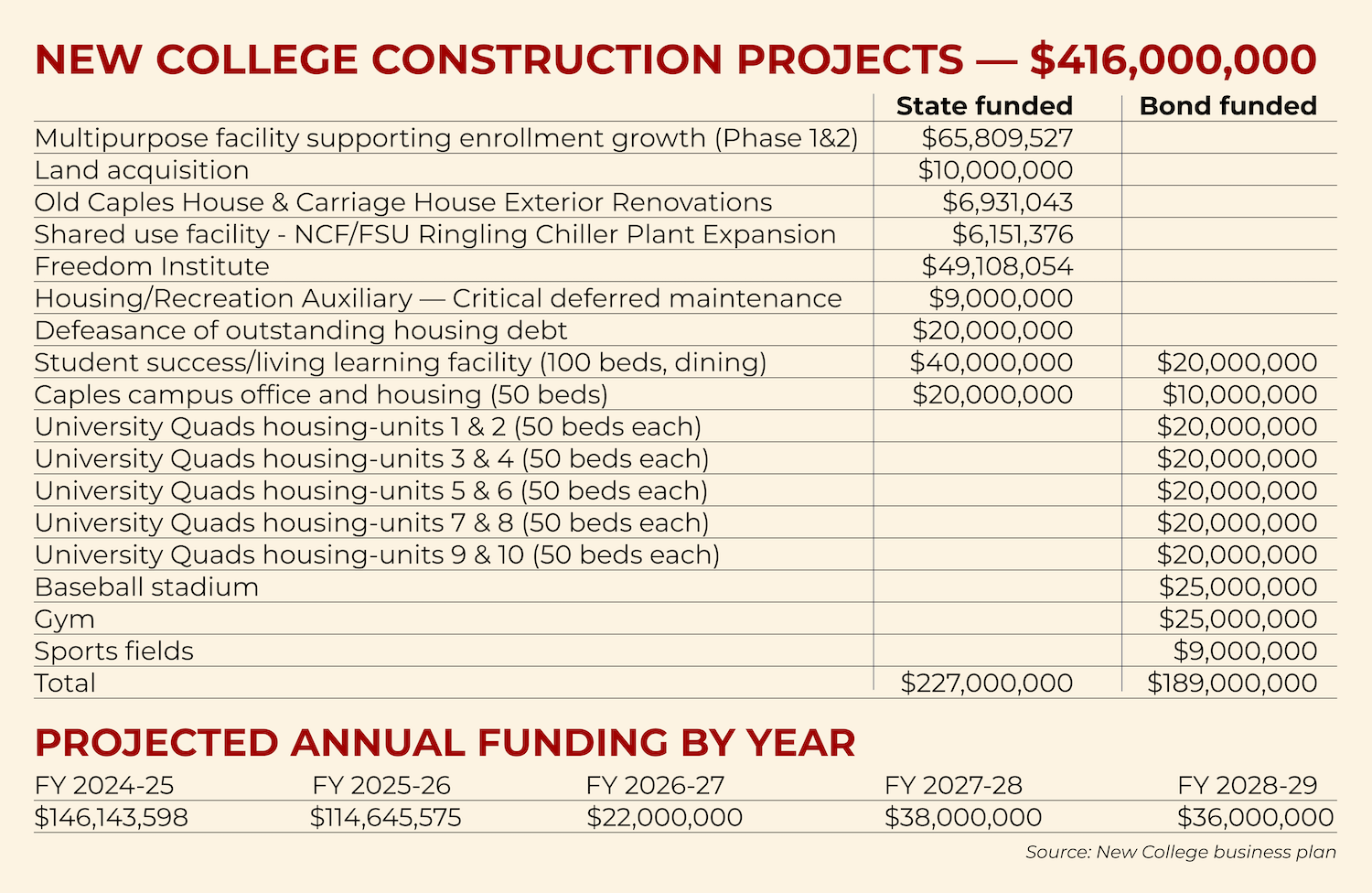- October 23, 2024
-
-
Loading

Loading

Everyone who has followed the life and times of New College of Florida probably remembers the legislative session of 2020.
That is when Rep. Randy Fine, R-Palm Bay, one of the Republican fiscal hawks and then a close ally of Gov. Ron DeSantis, surprised his legislative colleagues and everyone in Sarasota with a bill proposing to merge New College of Florida with Florida State University.
Fine, known for being direct, unapologetic and uncompromising, railed that New College and its sibling, Florida Polytechnic University in Lakeland, were costing taxpayers far too much money for what they were delivering and producing.
Many wondered: Where did this come from? The governor? Surely, Fine would not have made such a bold move without the governor’s blessing.
“We have an obligation to taxpayers to generate degrees at the lowest possible cost,” Fine told a Florida Politics reporter. “These two colleges cost an extra zero versus the other 10 in the system,” he told the Tallahassee Democrat.
“The problem with Florida Polytechnic and New College,” he said, “is they are so small, there are not a lot of students to spread these expenses around.”
You may remember: Fine’s bill died. The public outcry from Sarasota, Manatee and Polk counties snuffed it.
But the post-mortem talk among Sarasota and Manatee legislators was that New College needed to do something to turn things around. It now had a target on its back. “Something is going to happen there,” Sen. Joe Gruters told us then.
Alas, something indeed. Something totally opposite and incongruous with rational, fiscally minded politicians.
In the past four sessions since, Fine hasn’t touched the issue — even though he was (and is) right: Economically and fiscally, there is no justification to taxpayers to keep New College alive.
But lo and behold, two of Florida’s allegedly leading fiscally conservative politicians — Gov. DeSantis and former House Speaker and Florida Education Secretary Richard Corcoran — somehow believe it is worthwhile for Florida taxpayers over the next five years to pump $227 million in tax dollars and $189 million more borrowed through bond issues — $416 million altogether — essentially to create a new New College campus, complete with new dormitories, a Freedom Institute and athletic teams and fields of which even IMG Academy would be envious.
All this to fulfill Corcoran’s vision — or should we say: starry-eyed dream — of turning around what has always been a financially struggling, often gasping, liberal arts honors college into “the best liberal arts college in America.”
The question Gov. DeSantis and Florida lawmakers should answer and make the case is: Given New College’s 64-year history of financial teetering, should Corcoran’s noble quest, and frankly monumental turnaround, be executed and gambled with Florida taxpayers’ money?
Indeed, if you were asked to invest in this venture, with the expectation of a decent return on the investment, in all likelihood, you would say an unequivocal “no.”
The New College business plan is convincing.
We’re always told: Chase your dreams. Dream big. Shoot for the stars. Pursue your passion.
For all that, you can admire Richard Corcoran’s vision for New College. After a 30-year career in Tallahassee, he is pursuing a passion — the liberal arts.
If ever there was a champion of the liberal arts, Corcoran is a walking curriculum. He flexed that knowledge in the 104-page business plan. It’s probably the only business plan in America that quotes George Washington, Albert Einstein, Steve Jobs and the ancient Greeks.
“With this plan,” the business plan states, “we rely on a famous saying of the Greek mathematician Archimedes: ‘Give me a place to stand, and I will move the Earth.’ Give New College firm ground, and we will deliver on the promise of 1960.”
It’s probably the only business plan for a college that uses 700 words to explain in detail the failure of the Japanese education system for producing students who are more robots than independent thinkers.
According to Corcoran’s plan, “We will create an academic program that unites technological learning with the liberal arts so that we may achieve great success without sacrificing our idealism or, as befell Japan, a prosperous reality.”
The prose in the plan gets even deeper.
All that liberal arts idealism sounds impressive. But you feel like you’re reading a student’s dissertation from the 1970s book and TV series,
“Paper Chase,” starring the erudite Harvard law professor, the late actor John Houseman.
In typical business plans, potential investors don’t want to read 11 pages of narrative that includes an explanation of “the Ancient Greek concepts of Logos and Techne.” They want to know: How are you going to make money, stay in business and grow?
As with optimistic entrepreneurs, Corcoran has a proforma for New College enrollment that predicts it will grow from 700 to 1,200 in five years. By comparison, it took Larry Thompson and the Ringling College of Art and Design eight years, from Thompson’s start in 1999 until 2007, to go from 700 students to cross the 1,000-student threshold.
To boost enrollment, the business plan spells out three strategies — all of which will require millions of dollars:
The New College campus is far from a recruiting attraction. In fact, as you read Corcoran’s business plan, you can see a costly challenge to the turnaround. The campus has a $61 million maintenance backlog. The business plan lists 42 specific projects to be addressed, everything from “long overdue mold assessment” to refurbishing the Cook Hall kitchen to be able “to recruit top professionals” to resurfacing “pot-hole riddled” General Twining Road and more.
“New College has already invested more than $500,000 per year in the quality of food being served, improving from ‘D’ rated food to ‘A’ rated,” according to the business plan.
Corcoran is counting on the addition of sports as a key to enrollment growth. In this year’s budget, the school is spending $2,134,499 for the startup men’s soccer, baseball and basketball and women’s soccer, softball and basketball. In the fall, the school expects to add lacrosse, golf and volleyball.
So far, New College has enrolled 152 student-athletes and hired 10 coaches. The athletic director’s salary and benefits are $290,299; the men’s soccer coach is at $108,040; and the women’s lacrosse coach is at $94,058.
The business plan makes no mention of how these sports programs will generate pay for themselves.
In higher-education circles, one of the accepted maxims for success is this: Curriculum drives enrollment.
To that end, New College is introducing three new master’s degree programs: the nation’s first master’s in marine mammal science, along with establishing a New College Institute of Marine Mammal Science; a master’s in environmental economics and policy; and the third, a master’s in Educational Leadership.
What appears to be a linchpin to the New College turnaround is the creation of the Freedom Institute. The business plan says the college will require its first-year students to go through an orientation “which addresses the importance of free speech and inquiry … The New College Freedom Institute will promote tolerance of opposing views and a willingness to engage such views in civil discourse.”
The business plan shows construction of the Freedom Institute projected to cost $49,108,054 — a request to the Legislature over three years.

Add to that salaries and benefits for the 2023-2024 budget year. They are scheduled to increase 23% from the previous year, from $31.7 million to $39 million.
With costs approaching a half-billion dollars, it’s an understatement to say Corcoran and the New College board are embarking on a huge undertaking just to renovate and develop a small college campus. Add to that transforming at the same time the school’s entrenched curriculum, faculty and — this is the big one — culture.
Business people who have been through mergers and changes in ownership know that more often than not such transitions are fraught with pain, agony and disruption. When new bosses come in, typically there are waves of exoduses of longtime managers and staff members whose ways of operating are not in alignment with the new regime.
Corcoran has been going through that ever since his appointment as interim president in January 2023. In effect, when DeSantis inserted Corcoran into his position and loaded the New College board with strident voices in American conservative circles, even though they vowed to build on New College’s tradition as Florida’s liberal arts honors college, their message to the faculty, staff and students essentially was negative: “We’re throwing out most of what you do and starting over.”
For at least a year in any change in leadership and ownership, you can expect the turnover to be consuming and disruptive, if not destructive, to any cohesive culture.

That puts the new leadership in the throes of recruiting and bringing in a new team from the outside — often people with whom they haven’t worked and don’t know if they will fit. It’s the process that Jim Collins of “Good to Great” fame coined: Getting the right people in the right seats on the bus. It’s hard, long and costly.
Making this more difficult is the perception that filters out in the marketplace. While there likely are many professors and students who would prefer working and living on a campus of like-minded conservatives, it doesn’t help that when someone does a Google search for New College, not surprisingly, the preponderance of articles leans toward those attacking the New College board and Corcoran’s generous compensation ($699,000 annual salary, plus $200,000 in available incentive bonuses).
If Corcoran and New College were a private enterprise trying to raise capital in the public market, you can be sure many savvy investors would conclude: Why get involved? There are better, safer, less controversial bets.
Investors would make that conclusion just looking at the college’s financial history.
In spite of its academic achievements — “roughly one-third of all (New College) science graduates since 1967 have earned an M.D. or Ph.D.” and the most Fulbright scholars among Florida universities), operating losses are a New College tradition.
In 1975, 15 years after its founding, New College avoided bankruptcy by becoming part of the University of South Florida-Sarasota-Manatee. The marriage was a rocky clash of cultures that didn’t work.
In 2001, then-Senate President John McKay of Bradenton persuaded Gov. Jeb Bush and legislators to save New College again, giving it status as the state’s 11th independent public college. That also gave it access to state funding — and kept it alive.
But still today, New College’s finances fall on the bottom rungs of the state university system.
Mind you, none of Florida’s 12 universities would be in existence were it not for taxpayers’ funding. Tuition payments and fees don’t come close to covering the day-to-day operating costs. To operate at breakeven or achieve a surplus, the universities count on a myriad of sources of revenues.
But even then, over the past five fiscal years, in a sampling of seven of the universities, here’s a ranking of how many years they reported deficits:
University of Florida — 1
Florida State, Florida Atlantic, Florida Gulf Coast — 2
Florida Polytech — 3
University of South Florida, New College — 5
Perhaps more telling for taxpayers is how little student tuition and fees cover a university’s expenses and how much the schools rely on state funding.
For New College, tuition and fees have covered only 5.6% to 11% of day-to-day operating expenses. In contrast, at the University of Florida, Florida State, University of South Florida, University of Central Florida and Florida Gulf Coast University, tuition and fees cover from 30% to as high as 48% of operating costs.
State funding typically has made up 90% to 94% of New College’s annual operating revenues, while it accounts for 51% to 70% of the operating revenues for those other five universities.
Increasing enrollment can bring New College’s ratios more in line with the other state universities. But here is the conundrum: If New College is to be the best liberal arts honors college in the U.S. and Florida, with a peak enrollment reaching 2,000, its cost-per-student will always be high.
As the Legislature completes its 2024 session, it once again is appropriating record levels of taxpayer dollars to New College.
In the 2023 legislative session, lawmakers appropriated a record $66.5 million in general revenue and lottery funds, more than a 30% increase from the previous year.
In the session about to be completed, the appropriations bill allocates $82,334,334, a 24% increase over 2023-24 appropriations.
For $15 million of the $82.3 million, New College is required to submit a detailed business plan and quarterly reports to the chairs of the Senate and House appropriations committee — clearly a measure to hold Corcoran and the New College Board of Governors accountable.

But in the real world of private enterprise, investors would have asked tough questions before writing investment checks for $82.3 million.
Among those questions: What are the alternatives? If the state is to invest $500 million over five years, is there a better, more productive use for that capital?
We often tell the story of a board member of a large retail chain. After he listened to the CEO tell the board how the company was going to invest millions of dollars to improve its money-losing stores, the board member commented:
“Why not invest that money in our better and best performing stores to make them even better?”
We also asked a veteran of corporate boards to review the New College business plan with the thought of whether he would invest in President Corcoran’s plan to transform New College.
His response:
“To be the best liberal arts college in America: How will this be measured? It doesn’t say.
“Further, there was no timeline; nor a cash burn rate on the sports program.
“When I look at a business in which to invest, here is what I look for:
“Always the same six questions.
“I could not find the answers to any of these questions.”
Over its history and in spite of its challenges, New College of Florida triggers emotional community pride in Sarasota and Manatee counties, and rightfully so.
But for Florida taxpayers, the governor and Corcoran’s ambitions and dream to transform New College raise legitimate questions about their and the Legislature’s stewardship of taxpayer dollars.
Even though New College is just a tiny blip in the overall amount of money taxpayers contribute each year to Florida’s 12 universities — 1.6% of $5.13 billion, just imagine if any of you — with no experience in running a college or university — went to the governor and Legislature and asked them for $500 million to build “the best liberal arts college in America.”
Ha! They would send you packing.
Rep. Randy Fine was correct in 2020. New College should have been merged into one of the bigger universities or been sold. But here we are.
We wish DeSantis and Corcoran luck. But as many investors who put capital into startups and turnarounds know, more often than not, they require twice as much money and twice as much time — and no guarantee of success.